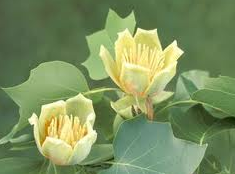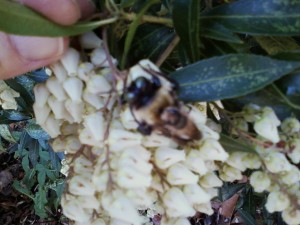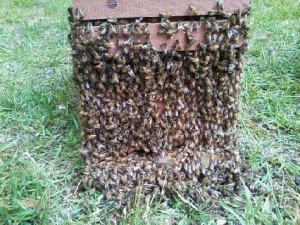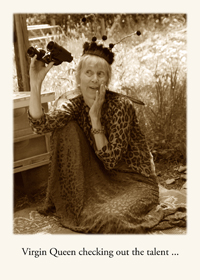Our honey flow has started here in the mountains of western North Carolina … about a month early. Blackberry bushes, tulip poplar trees and black locust are throwing out blooms like there is no tomorrow, offering up the best of their best in this wildly vibrant spring. An old timey bee guy I know who has lived here all his life, told me he has never ever seen a spring like this. My bee yard looks and sounds like rush hour in L.A. Bees are coming and going from the hives in an explosion of winged traffic; Sam Comfort calls this flying with purpose. It is astonishing to sit and watch. I have been in the yard, on and off, throughout these past weeks, reveling in the divine revelation of it all.
New queens were born in Fern, Muriel, Sacre Coeur, Rinpoche and Guadalupe nucs (short for nucleus or small starter colonies). These precious souls join Crow, Ganesha, Hanson, Madonna, Never Forgets, and Milagro hives. What a family, eh? And, wonder of wonders, I saw the virgin queen from one hive step out and take her mating flight. Virgin queens have no hips, but all being well they soon become voluptuous (and I’ll confirm that soon when I go in and check for eggs).
I’m in a bee delirium. I go to the apiary each morning and I can hear it even before I enter it; the bees have gone utterly Dionysian with their precious spring-imbibing selves. It is so full of life here! I put my ear to the hives and the Milagro and Ganesha colonies roar like honeybee-powered engines. The bees are bursting out of their britches. And some plants and trees that normally bloom in succession, are blooming at the same time (which really is odd as socks). I can’t think why a single human being in western North Carolina could be anything but happy right now. All our sap is rising …
There are four Pieris (Lily of the Valley) bushes outside my home office; one is by my window at eye level. We have 4,500 pollinators in our area and I swear that most of them were on that bush this spring; it is a pollinator orgy over here and every winged one of them is in a good mood. It was like the Star Wars bar scene every day … and the most interesting sighting was a very odd-couple pairing of a large bee with a much smaller “hitchhiker” bee on its back. I apologize for the picture quality (it’s blurry), but it was the best I could do in that moment.
For days, I saw this duo on those bushes. The smaller bee looks like a honeybee, but with my glasses on (!) I realized it was too small for a honeybee. I posted this on my Facebook page and other circles and it sparked conversation and interest from here to Australia. I have been in touch with various entomologists from around the U.S. and the consensus is that the pair is either southeast blueberry bees or carpenter bees, but no one is absolutely sure because while some solitary bees (which these are) have smaller mates that can do that on-the-back thing, everyone needs to see a clearer photo to be sure of who’s who. I tried to get a better picture for days but “dating season” was over, even when I looked around on other blooming plants. This is a next-year thing. The rhythm and calendar of my life is now marked by bee-ish events and that fills my heart with gladness.
What else? At this time of year, I am constantly (and happily) answering bee-ish questions by phone and email. I field other calls like an air traffic controller, connecting people spotting swarms with friends who want to catch them. I visit some yards and do post-mortem sleuthing. I’m volunteering for a research project for The Center for Honeybee Research that has two yards of hives at the WNC Nature Center (some overlooking the red wolves and the others, the bears). And I continue to do remote teaching for the College of the Melissae: Center for Sacred Beekeeping that is growing at the pace of its own frenzied spring … they are a wonderful community to bee-hold.
This week marks the third and last occasion of helping some friends with 600 nucs that are delivered to a farm. A small bee-sotted team of us join Stuart, Jon and Carl (the nuc biz guys) to check each colony to be sure it is whole, hearty, queen-right, and all-ways-right before being picked up by the bee stewards who paid for them. We are knee deep in bajillions of bees … for hours of humming hours. The nucs are chemical-free, full to bursting, healthy new daughter colonies that take the pollen for great queen / genetic lineages. Doing the “bee math” and estimating about 10,000 bees per colony, I will have personally met around 1,200,000 more bees by the end of this adventure … I am a wealthy woman.
I am in such an altered state after this happy work each year that it feeds my soul like a fine time-released feast. I think, talk and dream about bees, smell like bees, am stained with propolis, have farmer girl’s nails, my favorite bee yard clothes are turning into comfy “blankies”, and I have constant hat hair. What more could a girl want?
So, my friends, Caveat Bee-ster (made-up Latin for bee-lover beware): This kind of great good fortune could happen to you. If I am incoherent the next time I see you … if I am just staring at you blissfully and wordlessly, just know that I have continued to have the most amazing bee spring ever and that somehow you’ll be able to receive darshan from the bees through me, one way or another. I remain at the feet of the Sri Sri bee-jis (all six of them). This surely is a path to enlightenment.
Til next time beeloveds … Carpe bee-um
Blessed be. Blessed bees.
Debra















{ 11 comments… read them below or add one }
What a glorious environment, Nature and Human, for Fern to have been conceived and born in!! Utterly, utterly wonderful.
Deep Blessings to you….
Oh the pleasure was and is all mine … She was the first split of this bright year and helped set the explosive Divine Feminine tone … Looking forward to you all meeting tomorrow …. blessings xox
This makes me smile, Debra, a LOT!
Thanks, Linda! blessings!
Just now catching up on your blog, you must be so busy, with your last post in April, but what a post! I’m so happy to hear the news of abundance in NC. Our spring has been a good one too for the bees, consistent bloom from one kind of plant to the next. Right now the bees are on Palmer’s Penstemon and won’t give it up for much else, save the Rocky Mt. Bee Plant, which they adore. Great to meet you here in NM Deborah, have a wonderful summer!
Peter, thank you so much for this lovely message and was great to meet you recently in NM. What a great wee gathering it was. And very glad to hear your bees are thriving on those lovely plants. I just looked them up and both are beautiful and I am esp struck by the Palmer’s Penstemon … I don’t think I saw either of those plants on Hamaatsa land unless they bloomed after I left. Have a happy summer, too, and we’ll look forward to seeing you again when the Bee clan brings us all to the same bee-ish shores. blessings, Debra
Hi there Debra
Just discovered your site ..so much to know about Bees : )
I best read more, before writing back to you..
So what about the winter months With are buzzing friends?
Regards
Lee UK
Hi Lee, so good to hear from you. Do you have bees? Thinking of getting bees? Simply bee-sotted? In the winter, the bees cluster up to maintain warmth and are in a kind of slo-mo mode, not eating much, protecting the colony and queen until the warmer weather. For us, that is about 4.5 months but we have our occasional warm winter days where the bees emerge for a “cleansing flight” and also to harvest any winter pollen that might be available – some heathers provide that. Where are you in the UK? And yes, winter time is a great time to read about bees. blessings, Debra
whoah this blog is wonderful i like studying yur articles.Stay up the good work!
You recognize, a lot of individuals are searching round for this info, you could aid them
greatly.
Thanks so much. Appreciate your comment. Many blessings to you.
Wow, superb weblog layout! Hoow lengthy have you been blogfing for?
you made blogging look easy. The entire look of your website iis excellent, as well as the
content!